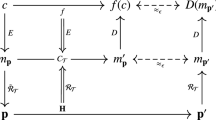Abstract
In computer graphics we use techniques from different areas of mathematics. Mathematical models are used to simulate real-world objects, as well as natural phenomena. In order to understand these models and pose relevant problems in each particular field of this area, it is important to create levels of abstraction. These levels encapsulate common properties of the different models and allow us to have a global, conceptual view of the methods and techniques in each field. In this paper we study a paradigm for creating abstraction levels that can also be used to characterize more general problems in computational applied mathematics. We apply this paradigm to different areas of computer graphics: modeling, animation, illumination, color theory, image processing and human-computer interface.
Similar content being viewed by others
References
Barzel R (1992) Physically based modeling for computer graphics. Academic Press, San Diego, CA
Blum L (1991) Lectures on a theory of computation and complexity ofver the reals. IMPA, Rio de Janeiro
Daubechies I (1992) Ten lectures on wavelets. SIAM books, Philadelphia, PA
Gomes J (1993) Modeling paradigms. SIGGRAPH '93 Course Notes
Gomes J, Velho L (1994) Image processing for computer graphics (in Portuguese). IMPA, Rio de Janeiro
Gomes J, Darsa L, Costa B, Velho L (1994) Graphic objects. Preprint, IMPA, Rio de Janeiro
Heckbert P (1982) Color image quantization for frame buffer display. Comput Graphics (SIGGRAPH '82 Proceedings) 16:297–307
Mantyla M (1988) An introduction to solid modeling. Computer Science Press, Rockville, Maryland
Miller JR (1989) Architectural issues in solid modelers. IEEE Comput Graphics Appl 9:72–87
Requicha AAG (1980) Representations for rigid solids: theory methods and systems. ACM Comput Surv 12:437–464
Requicha AAG (1983) Toward a theory of geometric tolerancing. Int J Robotics Res 2:25–37
Rosenfeld A, Kak AC (1976) Digital picture processing. Academic Press, San Diego, CA
Shapiro V (1990) Representations of semi-algebraic sets in finite algebras generated by space decompositions. PhD thesis, Cornell University
Shapiro V (1993) The ideal modeling paradigm. SIGGRAPH '93 Course Notes
Simmons GF (1963) Introduction to topology and modern analysis. McGraw-Hill, New York
Velho L (1993) Algorithmic modeling. SIGGRAPH '93 Course Notes
Voelcker HB, Requicha AAG (1993) Research in solid modeling at the University of Rochester: 1972–87. In: Fundamental developments of computer-aided geometric modeling. Les Piegl (Ed), Academic Press, San Diego, CA pp 203–254
Author information
Authors and Affiliations
Corresponding author
Rights and permissions
About this article
Cite this article
Gomes, J., Velho, L. Abstraction paradigms for computer graphics. The Visual Computer 11, 227–239 (1995). https://doi.org/10.1007/BF01901041
Issue Date:
DOI: https://doi.org/10.1007/BF01901041




